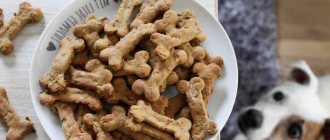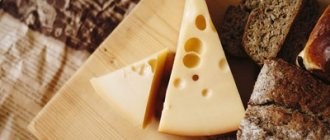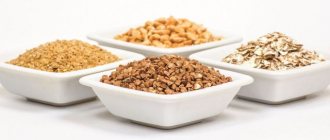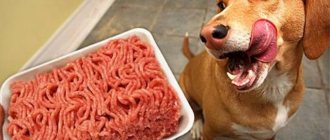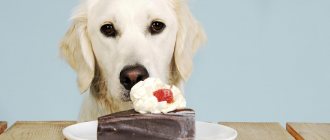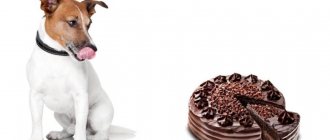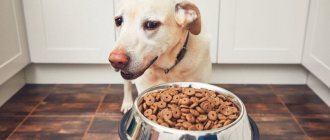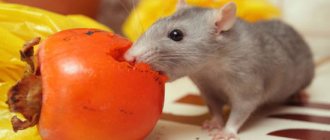- Freshly baked bread
Veterinarians do not recommend it for consumption by animals. Fermentation processes that continue in the product after baking injure and irritate the mucous membrane. This leads to heaviness, discomfort and deterioration in the dog’s general condition.
- Unleavened biscuits
When training an animal, you understand that it needs to be motivated in some way. Which one? The answer is simple: biscuits can be a good way of rewarding. This delicacy improves the immune system and is low in calories. This means that it practically cannot harm your pet. But, being a flour product, cookies contain a lot of fats and carbohydrates. Therefore, when treating your dog with this product, always control its quantity.
- Raw dough
Seeing this phrase, any owner will doubt the possibility of feeding their dog with it, and rightly so. Expanding in a warm environment, raw dough stretches the stomach and leads to loss of coordination, pain and other unpleasant consequences. Don't risk your pet's health! Keep an eye on what goes into his bowl.
- Baked goods with mold
This is not a famous French delicacy. Therefore, if you notice a spoiled product, get rid of it. Such baked goods are dangerous because they contain toxic substances. Its use leads to an imbalance in the functioning of the animal’s organs and disruption of the functioning of systems.
- Onion, garlic bread, raisin bread
Never give dogs onions, garlic, or raisins. Otherwise, it will lead to poisoning. Veterinarians claim that all this contains toxic substances and is toxic to animals.
Beneficial features
Feeding your pet bread is allowed. This product has many useful properties. But it should be given in moderation.
Fast saturation
Bread is rich in carbohydrates, so when added to food, the animal becomes full faster and completely satisfies the feeling of hunger..
Brushing teeth with crusts
If a pet eats crackers or dried bread crusts, it involuntarily cleanses the teeth of accumulated plaque.
In this case, bread brings particular benefits to animals that feed primarily on soft food.
Immune System Support
Rye bread is rich in lysine. This substance has a positive effect on the state of the cardiovascular system. In addition, it helps strengthen the immune system.
Optimal compromise
The most correct solution in all respects in this difficult situation seems to be making your own bread for your pet. You can do this, say, with your children, and in general, make a kind of family ritual out of it.
In this case, you can choose the ingredients yourself, and the process itself will not take much time. You can easily eliminate harmful ingredients such as salt and sugar, and you can replace them with healthy ones, for example, by adding honey or kefir.
The resulting bread is cut into small pieces and dried. This is how crackers are made. We talked about their additional benefits above. The bread recipe itself is not difficult to find on the Internet.
Rusks are subsequently added to food, dry food, soups, cereals, in fact, to any dish. But most importantly, according to trainers, this is the most effective and correct treat for an animal during training, including intense ones.
Features of the structure of digestion in dogs
The digestive system of pets is significantly different from that of humans. Therefore, they cannot be included in their diet in foods that people eat.
Difficulty digesting carbohydrates
Dogs are predators by nature. Their saliva does not contain enzymes designed to break down carbohydrates. Their production is possible only after eating carbohydrate foods. But digesting it still causes difficulties.
Short intestine
A dog's intestines are significantly shorter than a human's. It takes less time to digest food than in humans.
Accordingly, animals should eat easily digestible food that does not cause excessive stress on the digestive tract.
Content
1. If you can give a dog bread, what is its benefit? 2. Undesirable factors 3. Optimal compromise 4. Feeding tips
Bread, as a food product, has actively and firmly entered our daily lives, and in many cases, has taken a leading position. However, have you personally wondered whether it is possible to give bread to a dog, and how safe and advisable it is? We know very well that not all products from our daily or holiday table are relevant for pets. Let's consider this issue from the point of view of professionals: dog handlers, veterinarians, breeders.
Cons of this product
It’s worth figuring out why you shouldn’t give your pet bread. This product has a number of disadvantages.
High content of fast carbohydrates
Bread contains a large amount of fast carbohydrates. The animal’s gastrointestinal tract is not able to cope with their complete digestion.
High risk of developing pathologies of the cardiovascular system
Digesting bread requires enormous amounts of energy. Naturally, this negatively affects the condition of the heart and blood vessels.
Indigestion
Due to the consumption of baked goods, the functioning of the digestive tract is disrupted.
Constipation is often observed as a result of this. Diarrhea may also develop.
What to replace it with?
You can replace bread in your dog’s diet with unsweetened crackers, crispbread and unleavened biscuits. Such products do not harm the animal’s digestive tract and are digested normally, but do not forget - these are still carbohydrates, and their excess can cause excess weight and various diseases .
Many owners give bread to dogs to make them feel full faster. Instead of such a “filler,” use special flour made from sprouted grains: it can be safely added to food.
What diseases can it cause?
There will be no harm from eating bread once. Negative changes are observed if the animal eats bread systematically and in large quantities.
Obesity
This product belongs to the high-energy group.
If an animal is sedentary, a large amount of carbohydrates in its diet leads to weight gain. When their content in the diet is increased, obesity occurs. Against this background, the condition of the heart and joints worsens.
Pathologies of the gastrointestinal tract
It is very difficult for an animal to digest this heavy product.
Due to its frequent use, the risk of developing diseases of the digestive tract increases.
Allergy
Allergic reactions are observed when consuming flour products with additional additives (sesame, raisins) and are manifested by the following symptoms:
swelling of the limbs;- redness of the ears;
- severe itching.
Diabetes
It has been scientifically proven that introducing baked goods into your pet's diet increases the risk of developing diabetes.
Caries
Sweet buns lead to deterioration of tooth enamel and caries, so giving them to an animal is strongly not recommended.
Useful varieties
Not all types of bread are harmful to your pet. Some of them can have a positive effect on the body.
Avoiding white bread
White bread is bad for dogs. In the process of its production, purified refined flour, pressed dry yeast and a number of additional additives are used. This product does not provide any benefit.
Black and bran types: more benefit than harm
The most harmless varieties are black and bran bread. Such options can be given to a four-legged friend as an incentive treat.
The best choice: crackers and biscuits
Crackers are the easiest to digest. It is recommended not to purchase them in the store, but to dry them in the oven. Breads are also suitable. The main thing is to give this treat to the animal in small quantities.
Benefits for humans
Bread is the head of everything! Yes this is true. It helps you get full faster, makes your diet more satisfying and tasty, and it was bread that saved our grandparents from hunger during the war. But it turns out that not all bread is healthy .
Let's figure out why:
- it contains yeast - they do not die during heat treatment and continue to live, but in our body, inhibiting the beneficial intestinal microflora;
- it contains refined flour , purified of everything useful - this is ballast for our body, which causes excess weight gain;
- Sugar and are often added to the dough , which make it even more harmful.
Of course, there is always a healthier alternative - yeast-free sourdough bread , without harmful additives. It is tasty, healthy, but more expensive than a regular wheat loaf.
Another option, the healthiest: homemade bread , made either from whole grains or from rye flour with grown sourdough. You can eat this bread on both cheeks and not worry about your health.
Features of the diet of puppies and recently born dogs
Puppies are actively growing and constantly moving, so they need carbohydrates. You can give bread to babies, but only rye bread. It is recommended to soak it in low-fat broth. You can also introduce vitamin flour into your diet. To prepare it at home, you need to germinate oat or wheat grains and grind them into powder.
The basis of the diet of recently born dogs is vegetables, herbs and meat soups with the addition of cereals. Dairy products, bone meal, fish oil and fish are also allowed. Bakery products should be completely abandoned during this period.
Tips for owners: how to give bread so as not to harm
When using bread as a treat for your four-legged friend, you need to adhere to the following recommendations:
- do not give baked goods daily;
- you can’t feed the crumb: the yeast begins to ferment, causing colic;
Excessively soft baking is prohibited: it instantly turns into paste;- you should not give baked goods or even sweet crackers;
- moldy bread and fresh dough are strictly prohibited;
- You should not give flour to obese or aging dogs.
What is better not to give
Not all baked goods are suitable for pets. It is worth highlighting several prohibited options.
Yeast products
When they are introduced into the diet, fermentation begins in the stomach. There is bloating and excessive gas formation. This negatively affects the general condition of the animal.
Bread with various additives
Baking with garlic or onions provokes irritation of the gastric mucosa. These products also contain a substance that reduces hemoglobin in the animal’s body, so there is a risk of developing anemia.
From corn and soybeans
These products are quite difficult to digest. Due to their consumption, the animal’s digestion process is disrupted. Vomiting and diarrhea may occur.
Sweet pastry with jam, nuts and other additives
The muffin is not suitable as a treat for dogs. If it contains additional components, the harm to baking becomes more significant.
The following is not allowed:
jam;- chocolate;
- nuts;
- raisins;
- jam.
At first, the pet likes these buns, but soon after eating them, heaviness appears in the stomach and pain occurs.
Fried flour products
Flatbreads fried in a frying pan with added fat should not be given to your pet. Such food is very poorly digested and leads to a deterioration in the dog’s general condition.
Overeating bread and its consequences
Bread is not dog food. If you compare the energy value of different products, you can see the following picture:
| in meat (2 categories) g/100 g of product | in rye bread | in wheat bread | in breadcrumbs | |
| squirrels | 20.2 | 5.6 | 7.9 | 11 |
| fats | 7 | 0.9 | 1 | 3.8 |
| carbohydrates | 0 | 44.4 | 48.5 | 70.3 |
| energy in kJ | 602 | 841 | 946 | 1447 |
Bread contains an excess of carbohydrates, and this is the biggest danger. The dog, fortunately, will not overeat the bread. However, a hungry dog on a leash will feed on whatever the owner offers.
A high carbohydrate content leads to excessive weight gain, which leads to diabetes. In addition, such a diet causes changes in the microflora in the intestines. Carbohydrates disrupt the acid-base balance. Nature, when creating the predator, has provided for everything, and only protein foods can maintain the optimal ratio of acids and alkalis, which prevents the development of unnecessary microflora.
Opportunistic microorganisms multiply very quickly, begin to gain virulence and cause decay processes. The body cannot cope with this on its own.
First aid in an emergency
Even if a dog owner is responsible in organizing his pet’s diet and gives him only the right food, unforeseen situations may arise. For example, the dog itself stole a prohibited product from the table or, even worse, ate moldy bread.
You need to know what to do and whether veterinary help is needed. It is worth closely monitoring your pet’s condition in order to promptly identify symptoms of indigestion and poisoning. During this period, the animal needs to be provided with plenty of fluids.
The following signs should alert you:
- gagging;
- bloating;
- hiccups;
- diarrhea or constipation;
- hyperthermia.
If such symptoms appear, the dog should be given 1-2 tbsp. l. Enterosgel. This drug has a more powerful effect than activated carbon and helps remove toxins from the body.
If constipation occurs, it is recommended to use special laxatives . If they are not available, you can give your pet vegetable oil. If the situation is advanced, do a cleansing enema.
Another unforeseen situation that dog breeders sometimes encounter is that the animal choked on a cracker. Action must be taken without delay.
To help your pet, you should lift it by its hind legs and shake it sharply.
Thus, the cracker should fly out on its own. It would not be a bad idea to ask another person for help: at the moment of lifting the animal, he should sharply compress the rear ribs.
You should contact a veterinary clinic if the symptoms of poisoning do not disappear after first aid, and the dog’s condition worsens.
